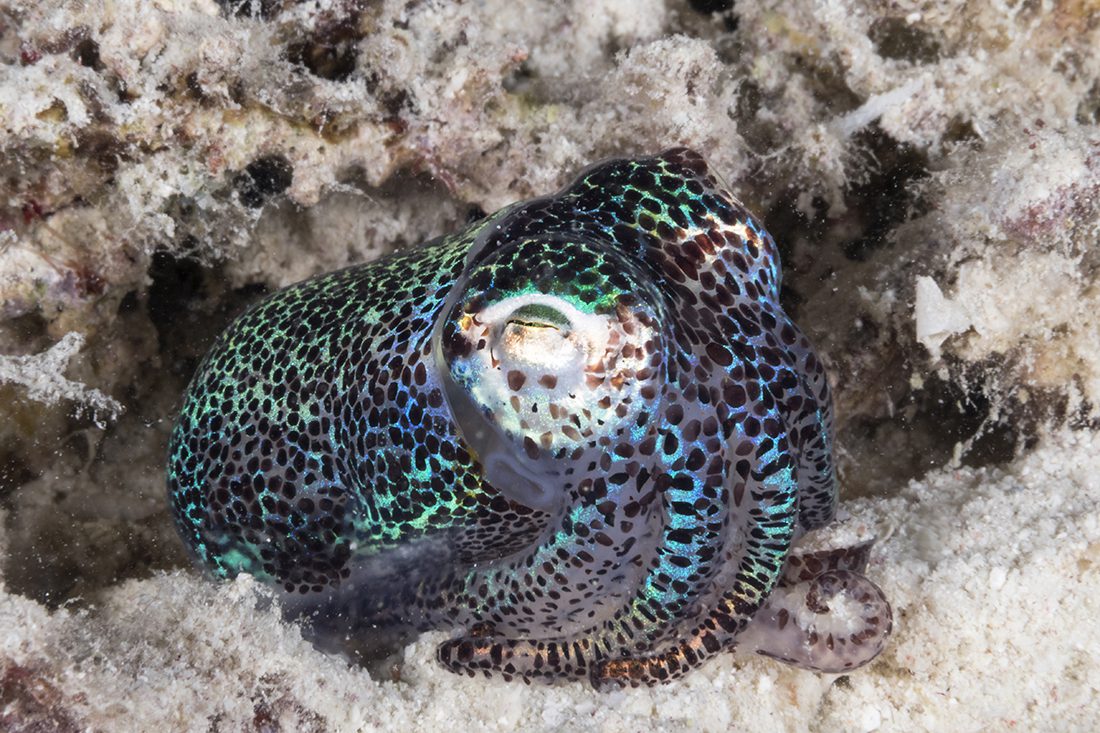Discovering the rewards of night diving at Wakatobi Dive Resort.
As the sun sinks towards the western horizon, guests at Wakatobi can look forward to a refreshing shower, a delicious dinner and perhaps a nightcap at the Jetty Bar. But not everyone is packing up the dive gear just yet. For some, nighttime is the right time for yet another visit to the reefs, where once-familiar landscapes are transformed by darkness, and a new cast of characters emerges. If you’re passionate about marine life, a night dive at Wakatobi Dive Resort is definitely in order.

The Night Shift
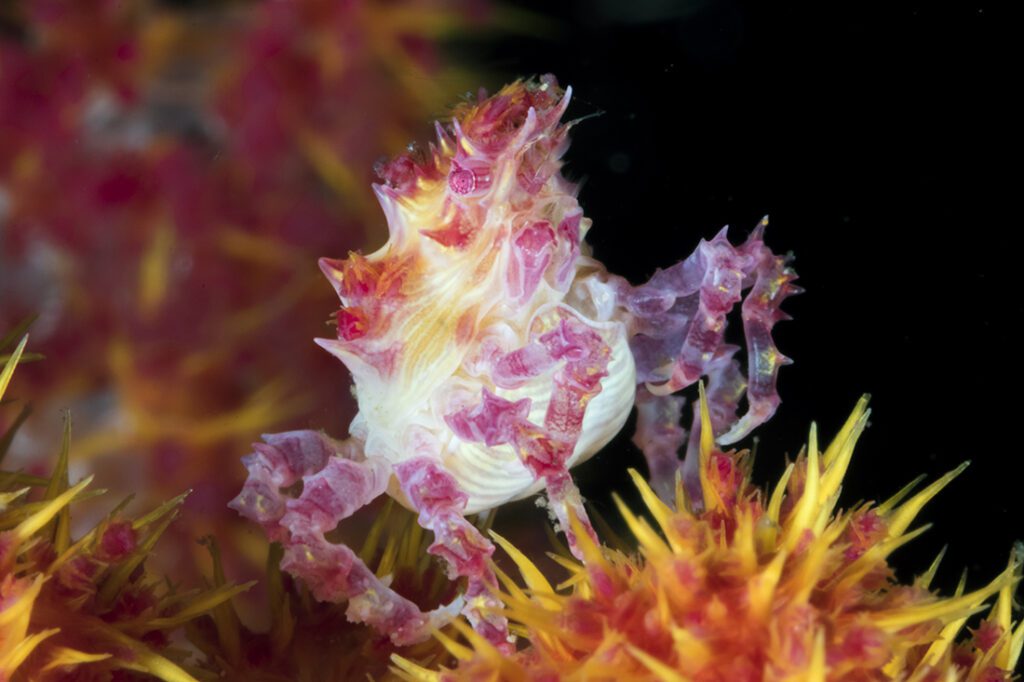
As sunlight wanes, the same reefs that provided hours of daytime exploration begin a transformation. Once-vivid colors become muted, and as shadows lengthen, perceptions of distance and motion are likewise diminished. Some have called this transition from daylight to darkness the shift change, as species active through the day seek shelter, while nighttime foragers and predators come out in full force. A quick sweep of the torch may reveal eels out and slithering through the corals, turtles napping with heads tucked into overhangs on the wall, and squadrons of squid jetting through the shadows. A swim along the reef provides a wealth of nighttime activity, and an entirely different cast of characters make an appearance on the grass beds and coral heads closer to shore.
At night, observant divers may find surgeonfish and other members of the day shift nestled deep into the recesses and crevices of the reef. Since fish don't have eyelids to close, they may not appear to be asleep, but they are in fact enjoying their version of an overnight rest. Some fish do more than just bed down for the night. The spot-tail butterflyfish will actually change coloration when making the transition from day to night, morphing the attention-getting stripes of its body into a concealing black spot near the dorsal fin.
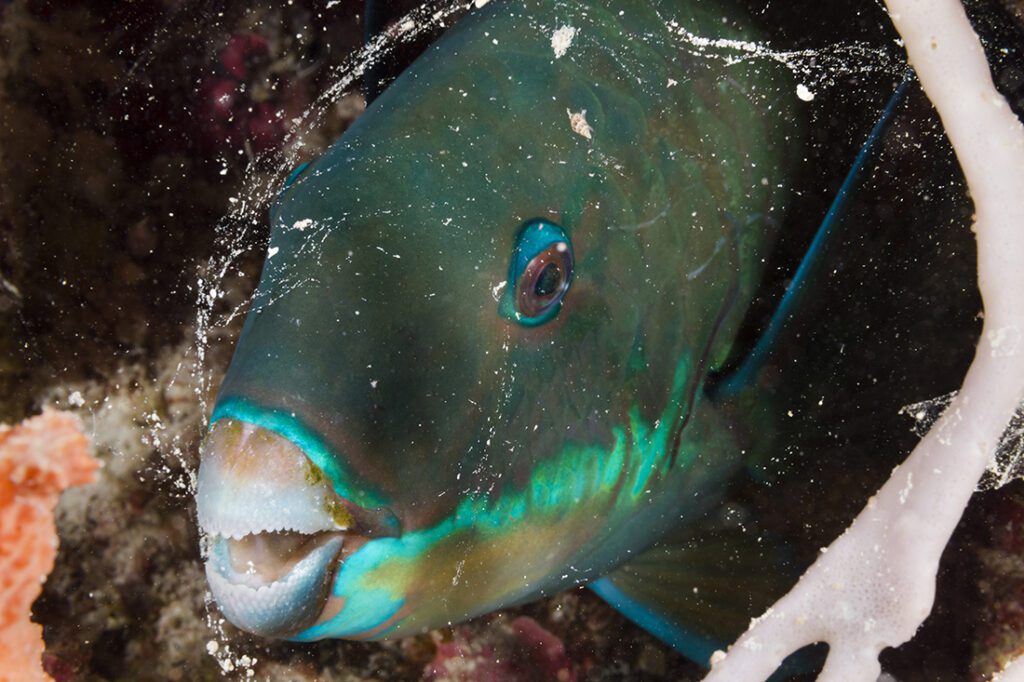
Parrotfish perform one of the best-known bedtime rituals on the reefs. When ready to retire for the night, they secrete a clear, jelly-like mucous bubble that envelopes their entire body like a cocoon made of clear jelly. This mucous covering serves as a first line of defense by hiding the parrotfish’s scent from potential predators, as well as acting as an early warning system, should something come in contact with the cocoon’s outer layer.
Nocturnal Adaptations
At the same time that all this bedding down is taking place, a very different cast of characters is emerging from hidden crevices and burrows. When the saron shrimp comes out of hiding, it undergoes a clever transformation as its body takes on shades of red that blends into the deepening shadows. After spending the day buried in soft sand, flamboyant cuttlefish emerge at dusk to hunt. These cunning, color-changing cephalopods can take on a range of vivid pink, purple, red and yellow hues and patterns that can be used for camouflage, communication or even to hypnotize potential prey. The effect can be equally hypnotic for divers fortunate enough to witness this light show.
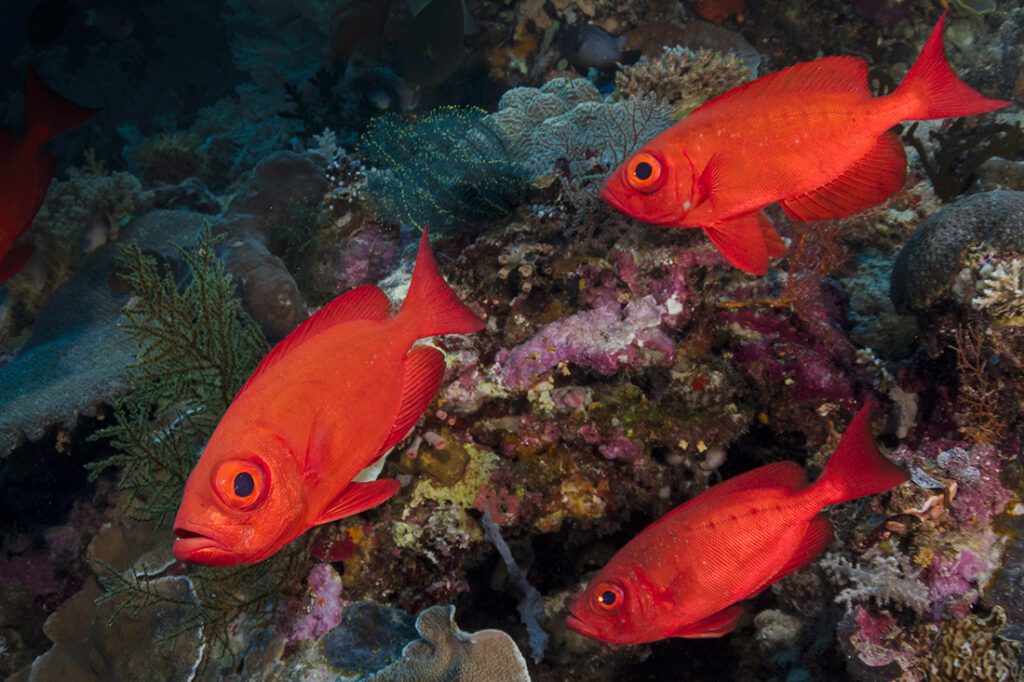
Nocturnal reef fish have developed some unique adaptations that help them find their prey with little or no available light. The seemingly oversized orbs of the crescent-tail bigeye are highly sensitive, and not particularly tolerant of harsh sunlight. This is why, during daylight hours, you will often find them in the shadow of a wall or seeking refuge under a ledge or the mouth of a cave. After dark, the pupils of the Crescent-tail bigeye large eyes further enlarge to allow even the smallest traces of light to enter and register on the retinal fronting of the optic nerve. This allows the fish to see in almost complete darkness, and though it's view of the world is more black and white than color, this proves ideal for detecting the indistinct outlines of prey that only come out at night.
Other creatures of the night rely less on their eyes than on other senses such as touch and smell, using highly-adapted sensory receptors to pick up vibrations and even the faintest whiffs of dinner or danger. Crabs swish brush-like olfactory organs fitted with chemosensory cells to trap and sample waterborne scents. The long antenna deployed by many shrimp are used for both touch and smell as they probe for food, and remain on high alert for potential threats. Most antenna-equipped creatures use their sensors to keep their distance, but some work together. In the shallows of the House Reef, night divers may come across a school of finger-sized striped catfish, holding in a tight-knit formation while using their whisker-like barbules to maintain contact with one another.
A Trip to the Zoo
While the House Reef provides endless hours of nocturnal adventure, guests will discover even more nightlife by going on one of the resort's regularly scheduled boat dives. A favorite is the site known as Zoo, which is one of the fishiest places around Wakatobi at any time of day or night. Trips are often scheduled to arrive around dusk so divers can witness fish in their bedding down behavior. As twilight fades, a range of creatures from crabs and shrimp to colorful flatworms emerge from the sheltering tangles of staghorn coral. This site is one of the best in the region to find the elusive twinspot lionfish, while squid and octopus are common.
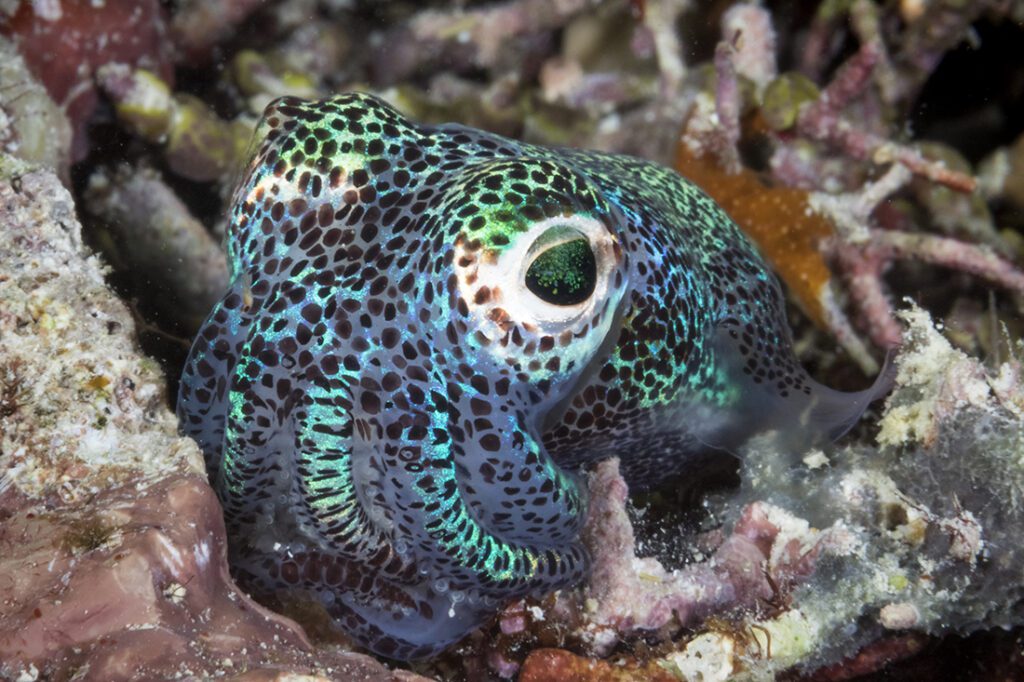
A favorite are bobtail squids that put on an amazing show as they transition through a wide range of patterns and color changes, using reflective properties in the pigment cells of their skin like sequins on a party dress. They may also employ more muted hues to blend into the background so they can ambush prey or escape predators. Also worth watching—but never touching—is the blue-ringed octopus. Having no internal skeleton, they can modify their shapes in dramatic ways, and undergo changes in color and texture to match their environment. When threatened, this small octopus will display its namesake blue rings, providing a vivid warning of its highly toxic nature.
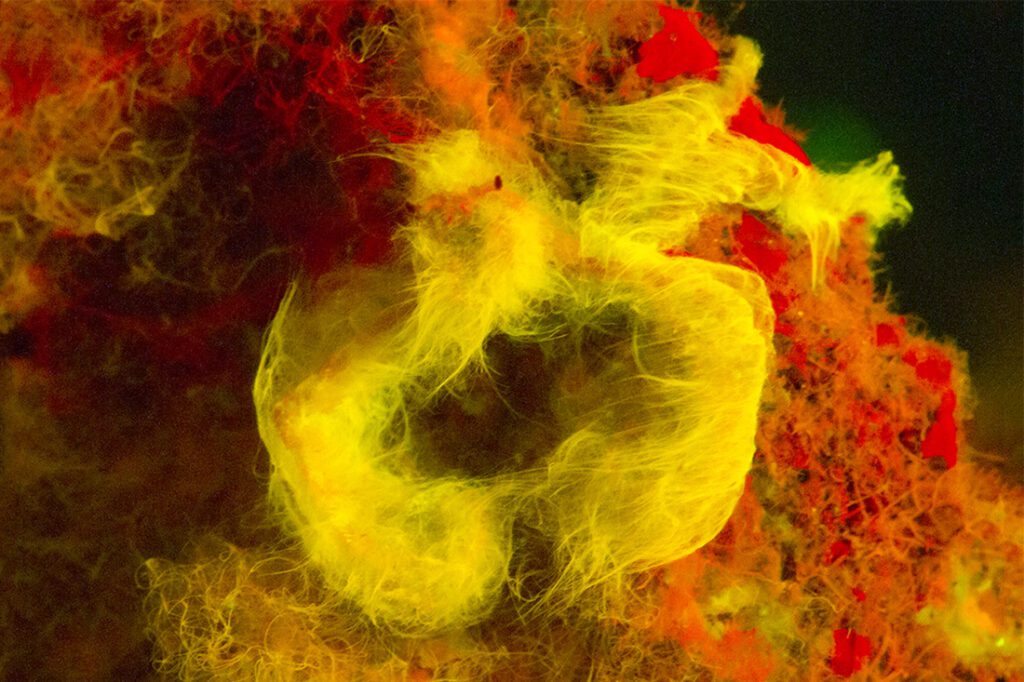
Zoo is also one of the sites used for one of Wakatobi Resort's most unusual nocturnal experiences. The phenomenon of “fluo-diving” was pioneered at Wakatobi Resort. This program provides divers with special blue UV lights, along with a yellow filter that fits over a dive mask. When the lights are swept along a reef, certain corals and animals are revealed in eerie fluorescing colors, similar to the glowing images on a black light poster. Not all forms of marine life fluoresce, but those that do can put on quite a show. Coral branches seem lit from within, and shrimp that might be a bland brown when lit by a conventional dive light can take on a bright green glow, as if radioactive.
Special Finds and Sand Dwellers
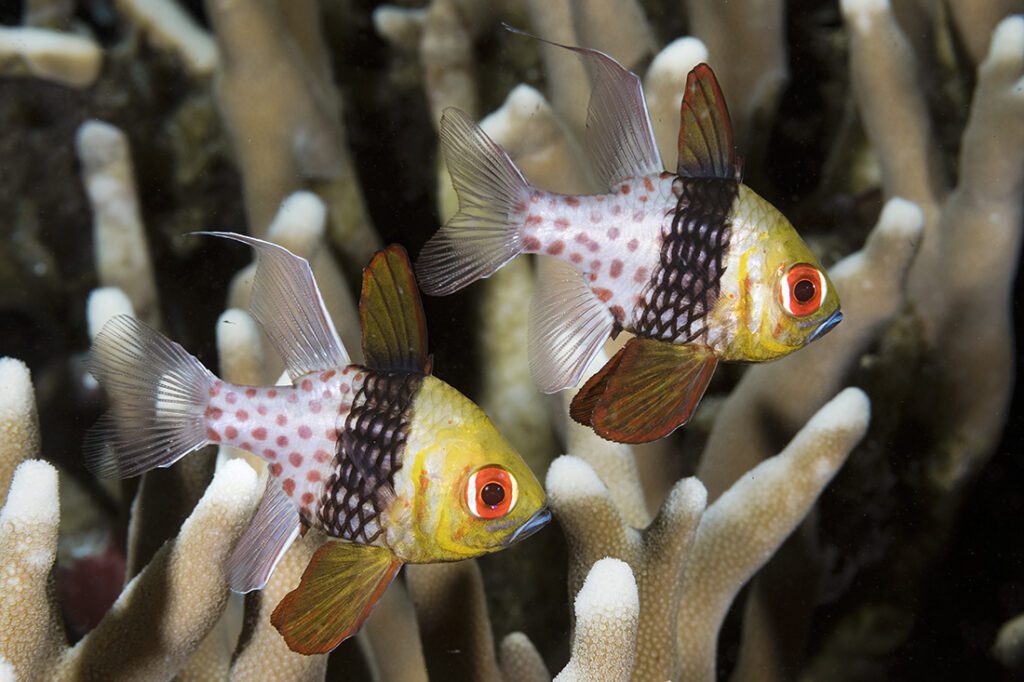
Another prime night dive location close to the resort is Dunia Baru, where a sloping shallow reef and an adjoining sand flat are home to several special finds. This is one of the best areas around Wakatobi Resort to find the pajama cardinalfish. You typically won't find these colorful little fish during a daylight dive on this site, as they spend the sunlit hours hiding under ledges and deep within enveloping coral formations. When caught in the beam of a torch, it's not hard to see how this fish got its common name. A black band around the fish's middle body separates a yellow front from a back end that is dotted with vivid orange spots. When combined with red eyes that appear bloodshot, this creates the anthropomorphic comparison to someone just startled from sleep.
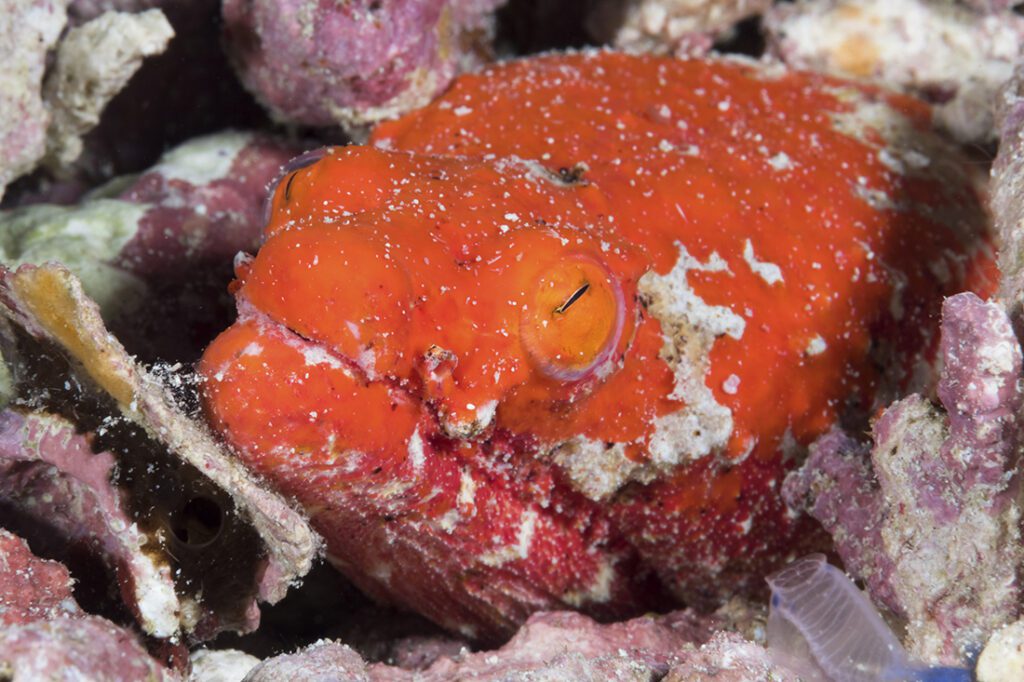
Dunia Baru is also a good location to look beyond the corals and explore nearby patches of sand bottom. One bizarre-looking animal often found here is the reptilian snake eel. This burrow dweller is difficult to spot in daylight, as it leaves only the tip of its snout out of its hole. After dark, it exposes its head and neck, working its jaws with seemingly sinister intent as it waits for a crustacean or mollusk to come within range. Another creature that will sprout up from the sand in the night is the feathered sea pen. Named for their resemblance to antique quill pens, these creatures are related to corals. By day, they stay buried in the sand. They emerge to bloom after dark, deploying their feather-like feeding tentacles. Although they are extremely delicate, if touched very gently, sea pens will emit a bright greenish light or bioluminescence. They may also force water out of themselves as a defensive act, deflating and retreating into their stalk-like body.
These are just a few of the many unique encounters that take place in the waters surrounding Wakatobi Resort after the sun goes down. We invite you to come, or come back, and discover the marine life treasures of that are revealed under the cover of darkness.
Don’t miss out on the incredible dives you can experience at Wakatobi Resort. Why not combine it with a cruise on Pelagian dive yacht for the best of both? Contact us at office@wakatobi.com or complete a quick trip inquiry at wakatobi.com.
Visit us on Facebook.
